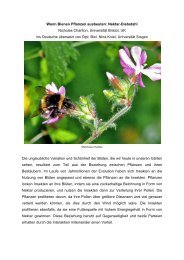PhDâ€theses - Ethologische Gesellschaft
PhDâ€theses - Ethologische Gesellschaft
PhDâ€theses - Ethologische Gesellschaft
You also want an ePaper? Increase the reach of your titles
YUMPU automatically turns print PDFs into web optimized ePapers that Google loves.
PhD‐theses<br />
EVOLUTION OF PLASTIC LIFE‐HISTORIES<br />
Barbara Fischer<br />
barbara.fischer@bio.uio.no<br />
Research Update<br />
PhD Thesis, 2010, Supervisors: PD Dr. Barbara Taborsky, PD Dr. Ulf Dieckmann, Dept. Behavioural<br />
Ecology, University of Bern, Switzerland and Evolution & Ecology Program, IIASA, Laxenburg, Austria<br />
Most environments fluctuate unpredictably at least to some degree, but surprisingly most life history<br />
models ignore stochastic environmental changes. By theoretical modelling we investigated the<br />
conditions favouring phenotypic plasticity of life histories, influences on the extent of plasticity in a<br />
trait and why and how much plasticity should change with age in stochastic environments. We<br />
analyzed how organisms should optimally allocate energy to reproduction vs. maintenance and how<br />
plastic they should be in their allocation decisions in environments differing by their degree of<br />
variability and predictability. It turned out that optimal reproductive investment should not increase<br />
monotonically with growing energy availability as one would intuitively assume. Instead, the reaction<br />
norm describing reproductive investment has a U‐shape, with high reproductive investment when<br />
energy availability is close to zero ('terminal investment') and when energy availability is high. At an<br />
intermediate level of energy availability, reproductive investment decreases to a minimum or even to<br />
zero. This indicates that in intermediate environments it can be optimal to skip reproductive events.<br />
Organisms may buffer the impact of environmental fluctuations by storing energy. So far, general life<br />
history models analysed optimal storage strategies in deterministic environments only. When<br />
incorporating stochastic changes of conditions, our model results suggest that when environments<br />
are almost constant, it is not optimal to store. Allocation to storage is favoured when environments<br />
become more variable and/or more predictable. Our results suggest that the simultaneous allocation<br />
of energy to reproduction, maintenance and storage can be optimal, which contrasts earlier findings<br />
from models in deterministic environments. Finally, we asked why plasticity should vary with age and<br />
whether there are windows of plasticity over life time. Many organisms possess 'plasticity windows',<br />
during which they are responsive towards external cues. When exposed to an environmental cue at a<br />
time outside the plasticity window, no adjustment occurs. We hypothesized that information gain<br />
through environmental sampling is a potential mechanism that can lead to the evolution of age‐<br />
dependent plasticity. Our results suggest that this mechanism may indeed give rise to a remarkable<br />
diversity of age‐dependent plasticity patterns, ranging from lifelong plasticity to narrow plasticity<br />
windows. As a specific example of the evolution of plasticity we modelled how mothers should solve<br />
the offspring size‐number trade‐off when environmental cues are unreliable. Our model results<br />
suggest that plastic offspring size strategies are superior to fixed strategies when environmental cues<br />
are at least moderately reliable. The plasticity threshold depends on plasticity costs and the diffe‐<br />
rence of resources available to mothers. Plastic strategies are increasingly favoured the more<br />
offspring survival varies between environmental states. The occurring switches between small and<br />
large offspring are predicted to be substantial, which is confirmed by those empirical studies that did<br />
find plasticity in offspring size to exist.<br />
Reference: Fischer, B., Taborsky, B. and Dieckmann, U. 2009. Unexpected patterns of plastic energy<br />
allocation in stochastic environments. American Naturalist, 173: 108‐120.<br />
7



